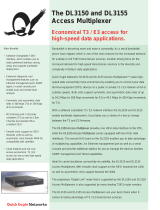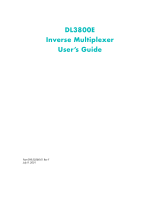Page is loading ...

The 4220 Access Multiplexer
WAN access with intelligence.
Main Benefits:
• Reduces cost of access by
balancing voice and data over
available bandwidth
•
Reduces network downtime
and maintenance costs through
integrated troubleshooting
features
• Provides full network
monitoring capabilities
•
Supports service level
agreement (SLA) verification
The demand for network intelligence is becoming pervasive. Every piece in the
WAN access chain needs to provide creative and cost-effective management
solutions that allow users to better monitor their network traffic. That’s why Quick
Eagle Networks has introduced the 4220 Access Multiplexer™. Here is an
access device that is available with full monitoring capabilities, enabling you to
take control of your network performance.
Besides this need for intelligence, access products have to provide an answer to
two other key business challenges: the ability to make better use of available
bandwidth, and the need to drive down total cost of ownership. The 4220
Access Multiplexer addresses both of these business concerns.
To maximize bandwidth usage, the device integrates data from one or two
external routers, together with voice traffic from a digital PBX, onto a fractional
to full T1/E1 WAN connection. Bandwidth allocation for the two data ports and
the drop-and-insert voice port is configurable through software.
The 4220 Multiplexer helps to reduce total cost of ownership for access devices
through its software-driven architecture that enables the device to be configured,
troubleshooted, monitored, and upgraded all from a remote location, meaning
that you don’t need to employ expensive resources at every location or send
your engineering staff all over the world just to keep your network running at
peak performance.
The 4220 Access Multiplexer – a more intelligent approach to WAN access.

Based on Quick Eagle Networks' sophisticated 4200 WAN Access Platform
architecture, this new device provides:
• Fractional to full T1/E1 support
• Frame Relay, Cisco HDLC, and Protocol Transparent support
• Two serial DTE ports
• Drop-and-insert port for voice integration from PBX
•
A full range of troubleshooting features, enabling:
• LMI conditioning
• Link-based testing and delay monitoring
• In-band Management
• Optional RMON-1 (frame-relay adapted) statistics
• Optional RMON-2 protocols and applications statistics
• Optional FRF.13 Frame Relay Service Level Agreement (SLA) Verification
The following figure shows the backpanel of the 4220 Access Multiplexer:
A more intelligent approach to WAN
access.
The following diagram shows a typical application supported by the 4220:
C
e
n
t
r
a
l
S
i
te
e
nt
T1
/
E
1
T1
/
E
1
T1
/
E
1
421
0
R
e
m
ote
S
i
te
PBX
PB
IPA
IPA
ccessESS
ESS
P
P
IPA
IPA
ccessESS
ESS
Router
R
Remote Site
e
mote Site
4220 Acc
ccess Multiplexe
ces
r

Access Speed
Network Interface
Network Port
Line Rate
Connector Type
Line Code
Framing
Output Level
Input Level
System Timing
Drop-and-insert Interface
Line Rate
Connector Type
Line Code
Framing
Data Interface
Interface Types
DTE Port 1, DTE Port 2
Data Rates
Management Connectors
COMM Port
Ethernet
WAN Protocols
Power Requirements
Voltage
Consumption
Regulatory
Diagnostics
Loopback Tests
Loopback Control
Test Patterns
Network Alarms
Data port alarms
Front-panel LEDs
Physical
Dimensions
Weight
Environmental
Operating Temperature
Storage Temperature
Relative Humidity
Maximum Altitude
T1
1 T1 ANSI 403 port
T1 (1.544 Mbps ± 50 bps)
100 ohm RJ-48C socket
AMI or B8ZS
D4 or ESF
0 db, -7.5 db, or -15 db LBO
0 to -26 db
Network, DTE, Aux, internal
T1 (1.544 Mbps ± 50 bps)
100 ohm RJ-48C socket
AMI or B8ZS
D4 or ESF
RS-449/EIA-530 or V.35
DB-25 socket
Nx56/64 kbps (N=1 through 24)
RJ-45 socket
RJ-45 socket
Frame Relay, Cisco-HDLC, and Protocol
transparent support
100 VAC to 240 VAC, 50-60 Hz or -40
VDC to -72 VDC (both on the same platform)
9 W maximum
FCC Part 15, FCC Part 68, UL 1950
Third Edition, Industry Canada CS-03
VCCI Class 1 CAN/CSAC22.2 No. 950-95
T1 network, T1 payload, fractional T1
payload, loop-up/loop-down commands, DTE
(full or fractional), NET/DTE
T1 set/reset codes, ESF FDL per
AT&T 54016 and ANSI T1.403 Annex B
1:1, 1:2, 1:4, 1:7, 3:24, QRW, all 0s, all 1s,
smart jack, two user-programmable 24-bit pat
terns, bit error injection
Net carrier loss, net sync loss, net AIS
received, net yellow received, CRC,
BPV, OOF threshold
RTS loss, DTRloss
Power/test, in-band, network status,
network loopback, loopback acknowledge,
DTE loopback, TD, RD,CTS, RTS, DTR
1 RU, rack mountable
22.3 cm (8.75 in ) W, x 33 cm (13 in) D, x 4.13
cm (1.63 in) H
2.27 kg (5 lbs.)
0º - 50º C
-20º - 60º C
0 - 95% non-condensing
4.6 Km (15,000 ft)
4220 Multiplexer
© 2007 Quick Eagle Networks. All rights reserved.
PDF/05/07
The information presented herein may change without notice
and should be used for informational purposes only. 4220
Access Multiplexer is a trademark of Quick Eagle Networks.
E1
1 E1 G703/G704 port
E1 (2.048 Mbps ± 50 bps)
120 ohm RJ-48C socket or 75 ohm BNC
HDB3
ITU-T G.704/CTR 12
ITU-T G.703/CTR 12
0 to 20 dB
Network, DTE, Aux, internal
E1 (2.048 Mbps ± 50 bps)
120 ohm RJ-48C socket or 75 ohm BNC
HDB3
ITU-T G.704/CTR 12
RS-449/EIA-530, V.35, or X.21
DB-25 socket
Nx64 kbps (N=1 through 31) (structured),
32x64 kbps (unstructured)
RJ-45 socket
RJ-45 socket
Frame Relay, Cisco-HDLC, and Protocol
transparent support
100 VAC to 240 VAC, 50-60 Hz or -40
VDC to -72 VDC (both on the same platform)
9 W maximum
European harmonized standards 73/23 EEC,
91.31/EED, 89/336/EED, 93/68/EEC, and
91/263/EEC; UL 1950 3rd Ed.; CAN/CSA
C22.2 No. 950-95; Comision Federal de
Telecommunicaciones; CISPR 22 Level B (EN
55022), RoHS compliant
E1 network, E1 payload, fractional E1
payload, loop-up/loop-down commands,
DTE (full or fractional)
E1 set/reset codes
1:1, 1:2, 1:4, 1:7, 3:24, QRW, all 0s, all 1s, two
user-programmable 24-bit patterns, bit error
injection
Loss of signal, loss of frame, remote
alarm indication, alarm indication
signal, CRC4, CV, FE
RTS loss, DTR loss
Power/test, in-band, network status,
network loopback, loopback acknowledge,
DTE loopback, TD, RD,CTS, RTS, DTR
1 RU, rack mountable
22.3 cm (8.75 in ) W, x 33 cm (13 in) D, x 4.13
cm (1.63 in) H
2.27 kg (5 lbs.)
0º - 50º C
-20º - 60º C
0 - 95% non-condensing
3048 m (10,000 ft)
Northern, Central & Eastern Europe
Southern Europe, Middle East & Africa
Asia / Pacific Rim
Latin, Central & South America
Canada
Headquarters
Quick Eagle Networks (USA)
830 Maude Avenue
Mountain View, CA 94043
+1 650-962-8282 Phone
+1 650-962-7950 Fax
www.quickeagle.com
/







